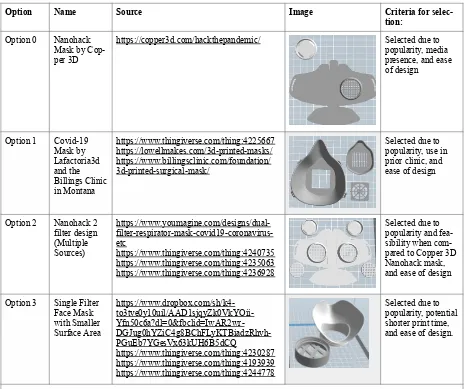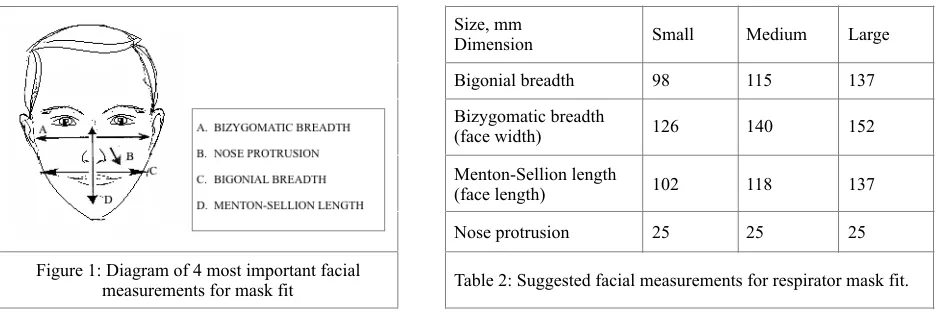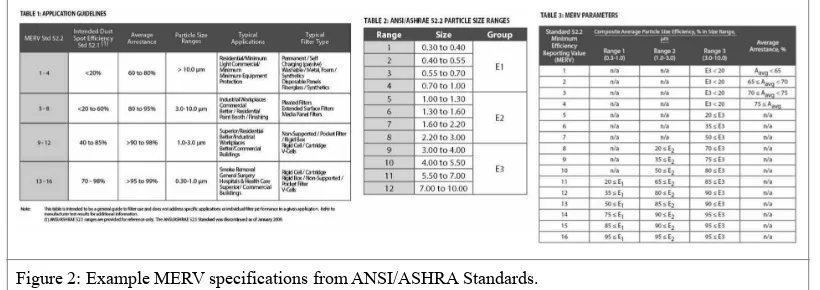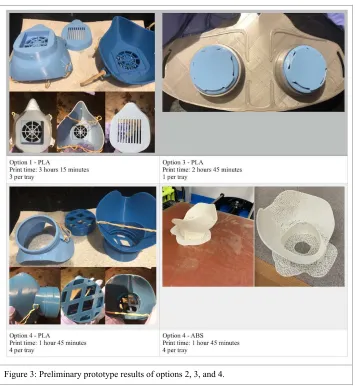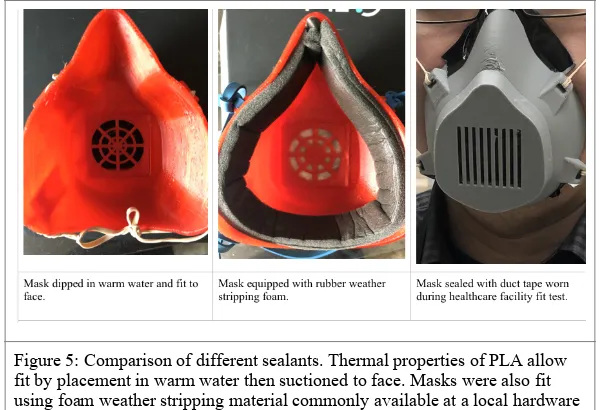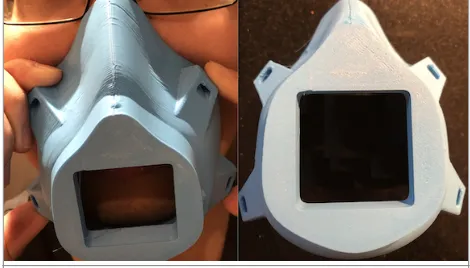Rapid Prototyping of Reusable 3D-Printed N95 Equivalent Respirators at the George
Washington University
Destie Provenzano MS* 1, Yuan James Rao MD* 2, Konstantin Mitic1, Sofian N. Obaid1, Dominique Pierce4, James Huckenpahler5, Jeffrey Berger MD3, Sharad Goyal MD2, Murray H. Loew PhD1
March 28, 2020
* These authors contributed equally to this work.
1 Biomedical Engineering, George Washington University School of Engineering and Applied Science, Washington, DC 2 Radiation Oncology, George Washington University School of Medicine and Health Sciences, Washington, DC 3 Anesthesiology, George Washington University School of Medicine and Health Sciences, Washington, DC 4 Libraries and Academic Innovation, The George Washington University, Washington, DC
5 Corcoran School of the Arts and Design, The George Washington University, Washington, DC
Correspondence should be directed to: Murray H. Loew, PhD
Biomedical Engineering
George Washington University School of Engineering and Applied Science Science and Engineering Hall
800 22nd St., N.W., Suite 5000 Washington, DC 20052 USA +1-202-994-5910 (T) loew@gwu.edu
Running Head: N95 Equivalent 3D Printed Respirator
Keywords: COVID-19, SARS-CoV-2, Coronavirus, Novel Coronavirus, 3D Printing, N95, Respirator, Mask Conflict of interest: None
Abstract:
The 2019 Novel Coronavirus (COVID-19) has caused an acute reduction in world supplies of personal protective equipment (PPE) due to increased demand. To combat the impending shortage of equipment including N95 masks, the George Washington University Hospital (GWUH) developed a 3D printed reusable N95 comparable respirator that can be used with multiple filtration units. We evaluated several candidate prototype respirator models, 3D print-er filaments, and filtration units detailed hprint-ere. Our most recent working model was based on a respirator found on an open source maker website and was developed with PLA (printer filament), a removable cap, a removable filtration unit consisting of two layers of MERV 16 sandwiched between MERV 13, and removable elastic bands to secure the mask. Our candidate mask passed our own suction test protocol to evaluate leakage and passed a qualitative Bitrix N95 fit test at employee health at GWUH. Further efforts are directed at improving the current model for seal against face, comfort, and sizing. The 3D model is available upon request and in the supplement of this paper. We welcome collaboration with other institutions and suggest other facilities consider mask fit for their own population when exploring this concept.
1.0 Background:
The 2019 Novel Coronavirus (COVID-19) has caused an acute reduction in world supplies of personal protective equipment (PPE) due to increased demand. The DC area has faced an extreme shortage of equipment including N95 masks. Our group at the George Washington University School of Engineering and Applied Science and Hospital chose to tackle this problem of a deficiency of N95 masks by 3D printing reusable respirators. We tested a series of different prototype models, filaments, filter materials, 3D printers, and sealant material to determine an optimal pro-tocol for rapid prototyping of a reusable 3D printable N95 equivalent respirator for the hospital. This study details the results of our preliminary trials that produced a reusable mask that passed a qualitative hospital Bitrix fit test. We seek to provide guidance and suggestions for methods to implement a rapid prototype and development of a similar 3D printed mask at additional healthcare systems and facilities.
2.0 Methods: 2.1 Overview:
Our study sought to evaluate prototype modules that would be sufficient to replace N95 masks should they become unavailable due to the COVID-19 pandemic. Each 3D model was created to act as a respirator that supported a fil-tration cartridge as well as allowed for a seal around the lower face of the provider. Each design requires a filfil-tration
unit, and should not be used without adequate filtration materials. The 3D printed respirators were designed to direct airflow through a smaller filtration area on the front of the mask to reduce size of filtration material required. This approach allows for reduced use of filtration material by standard N95 masks and allows for use of multiple filtra-tion cartridges.
2.2 Mask Prototype:
3D printing passes a digital file to an additive manufacturing device such as a 3D printer to create a three dimen-sional solid object layer by layer. Digital files are often made available to the general community in the maker space in stl, .obj or even CAD formats. Digital files were processed, modified, and prepared in GrabCAD , Meshmixer , i ii Slic3r, and Meshlab . We evaluated prototype respirator digital files for testing based on popularity, preliminary iii iv evaluation of feasibility by physician, and use by other developers and clinics. Selected initial candidate prototypes were all publicly available on Thingverse or elsewhere (Table 1). v
A 2004 NIOSH study based on 3997 heads , and 2005 study based on a half-piece respirator study that suggested a vi Simulated Workplace Protection Factor (SWPF) for respirator masks, together found that there were substantial and significant differences between the effectiveness of one-size-fits all face masks . Regression analysis of SWPF vii found the most important of 12 facial dimensions to be bigonial breadth, face width (bizgomatic breadth), face length (menton-sellon length) and nose protrusion. (Figure 1) Though not formally tested, the 2005 data was nearly normally distributed and suggested a basis for three potential sizes of masks (Table 2). For this preliminary trial viii we opted for a mask in between a medium and large size for testing. (Menton-Sellion=132 mm, Bigonial=96mm, Nose=43 mm).
Option Name Source Image Criteria for
selec-tion:
Option 0 Nanohack
Mask by Cop-per 3D
https://copper3d.com/hackthepandemic/ Selected due to
popularity, media presence, and ease of design
Option 1 Covid-19
Mask by Lafactoria3d and the Billings Clinic in Montana https://www.thingiverse.com/thing:4225667 https://lowellmakes.com/3d-printed-masks/ https://www.billingsclinic.com/foundation/ 3d-printed-surgical-mask/
Selected due to popularity, use in prior clinic, and ease of design
Option 2 Nanohack 2
filter design (Multiple Sources) https://www.youmagine.com/designs/dual- filter-respirator-mask-covid19-coronavirus-etc https://www.thingiverse.com/thing:4240735 https://www.thingiverse.com/thing:4235063 https://www.thingiverse.com/thing:4236928
Selected due to popularity and fea-sibility when com-pared to Copper 3D Nanohack mask, and ease of design
Option 3 Single Filter
Face Mask with Smaller Surface Area https://www.dropbox.com/sh/k4- to3tve0y10uil/AAD1sjqyZk0VkYOii- Yfn50c6a?dl=0&fbclid=IwAR2wr- DGJug0hYZiC4g8BChFLyKTBiadzRhvh-PGuEb7YGesVx63kUH6B5dCQ https://www.thingiverse.com/thing:4230287 https://www.thingiverse.com/thing:4193939 https://www.thingiverse.com/thing:4244778
Selected due to popularity, potential shorter print time, and ease of design.
Table 1: 3D digital sources and files of respirator prototypes evaluated and ultimately printed by this study. All mask proto-types were evaluated and ultimately selected for initial printing based on Biomedical Engineer and Physician feedback.
!
!
!
2.3 3D Filaments:
A 3D filament is a plastic that is used in conjunction with a 3D printer to create a layer-by-layer three dimensional physical model of a digital file. 3D filaments may come in plastic form in addition to other materials. The two most popular materials are Acrylonitrile Butadiene Styrene (ABS) and Polylactic Acid (PLA) . We evaluated a series of ix filaments for our 3D printing purposes. Initial review was conducted of ULTEM 1010, PC-ISO, Nylon PA, ABS-M30i, PPSF/ PPSU, PEEK, MED610, ABS, PLA, and TPU. (Table 3) Standard 3D printing protocol for medical devices typically seeks to use filaments that are able to be autoclaved to assist in sterilization. We anticipated that x materials used could be disinfected with soap and water or alcohol per CDC guidance. Thus readily available plasxi -tics that were not heat resistance were also considered. Preliminary masks were printed from TPU, ABS, and PLA filaments due to their immediate availability at the George Washington University. Due to the difference in melting temperature and difficulty in printing, TPU was not used in a first edition prototype. Results are presented for tests from ABS and PLA. A 1 kg roll of PLA can produce roughly 12 masks in the medium - large range, suggesting cost of materials to be around $1 - 2 USD per mask.
2.4 Equipment - 3D Printers:
Respirator prototypes were printed on a series of 3D printers available to the George Washington University through the School of Engineering and Applied Science, Library, Corcoran School of the Arts, and home printers of faculty and students. Our study was able to scale production based on crowd-sourcing and inclusion of home-printers and other resources throughout the university. Four Original Prusa i3 MK3 printers and two Prusa i3 MK2 printers , xii
Size, mm
Dimension Small Medium Large
Bigonial breadth 98 115 137
Bizygomatic breadth
(face width) 126 140 152
Menton-Sellion length
(face length) 102 118 137
Nose protrusion 25 25 25
Figure 1: Diagram of 4 most important facial
measurements for mask fit Table 2: Suggested facial measurements for respirator mask fit.
!
Material Heat
Re-sistant Tensile Strength, Yield Tensile Modulus HDT
ULTEM 1010 X 64 MPa (XZ Axis) and
42 MPa (ZX Axis) 2770 MPa (XZ Axis) and 2200 MPa (ZX Axis) 216 °C
PC-ISO X 57 MPa 2000 MPa 133 °C
Nylon PA X 43 MPa 1586 MPa 180 °C 95 °C
ABS-M30i X 31 MPa 2,180 MPa 96 °C
PPSF/ PPSU X 55 MPa 2100 MPa 230 °C
PEEK X 98 MPa 4000 MPa 152 °C
MED610 X 50-65 MPa 75-110 MPa 45-50°C
TPU 60-80 MPa 0.483 - 5.50 GPa 51.0 - 199 °C
ABS X 27 MPa 2.1 - 7.6 GPa 98°C
PLA 37 MPa 4 Gpa 49-52°C
five Stratasys F370 3D Printers , 10 Makerbot Replicator printers , and one Flashforge Adventurer 3 Lite were xiii xiv xv used to print initial prototype models.
2.5 Filtration Capabilities
N95 masks and respirator designation is defined by the United States National Institute for Occupational Safety and Health (NIOSH, regulation 42 CFR Part 84) as filtration of at least 95% of 0.3 micron particles . The N-series are xvi tested against a mildly degrading aerosol of sodium chloride (NaCl). The R-series filters are tested against a highly degrading aerosol of dioctylphthalate (DOP). Examples of efficiency of N95 and related NIOSH filter designations are included below (Table 4):
As N95 and related filters are becoming difficult to source during the COVID-19 pandemic, alternative filtration materials are being investigated at the George Washington University. A possible candidate are air filters under the designation of American National Standards Institute and American Society of Heating, Refrigerating and Air-Con-ditioning Engineers (ANSI/ASHRA Standard 52.2-2017). The efficiency of these air filters are classified using xvii the Minimum Efficiency Reporting Value (MERV). MERV is expressed on a 16 point scale and is derived from the particle size efficiency (PSE) of filtration. Examples of MERV designations, air filter uses, and filtration efficien-cies are listed below (Figure 2):
Based on the above specifications, it is conceivable that MERV16 filters may be a candidate replacement for the N95 filter, and filters of MERV 11-16 material may also be viable filters if enough layers of material are used. We considered four initial potential filter material components of a MERV 16, MERV 13, Smaller piece of an original N95 mask, and multiple layers of cotton for this study. We ultimately evaluated a filter cartridge consisting of two layers of MERV 16 sandwiched between two layers of MERV 13 material at a fit test. The reason for the MERV 13 sandwich is that some MERV16 filters might contain fiberglass, which is a potential health hazard, and the MERV13 filter will reduce the hazard of fiberglass inhalation. In contrast, MERV13 filters do not typically contain fiberglass. We assumed that the filter material performed according to the claims of the manufacturer. A sheet of MERV 16 combined with a sheet of MERV 13 can produce about 1,000, 40 mm x 40 mm (on average) squares of respirator material. This brought out cost per filter to be about $0.10 USD.
2.6 Sealant Material:
Filter Designation Minimum Efficiency Test Agent Maximum Test Challenge Loading
N100 99.97% NaCl 200 mg filter loading
N99 99% NaCl 200 mg filter loading
N95 95% NaCl 200 mg filter loading
R100 99.97% DOP 200 mg filter loading
Table 4: Filter Designations as defined by the United States National Institute for Occupational Safety and Health (NIOSH).
Figure 2: Example MERV specifications from ANSI/ASHRA Standards.
Special mention should be made of the difference between a 3D printed surgical mask and 3D printed N95 mask. Both masks are classified as respiratory protective barriers. A surgical mask is a loose fitting disposable device be-tween the face and mask. FDA guidance for N95 masks suggests masks must have a close fit, and seal around the edges of the face and nose.xviii We tested a series of methods to seal the mask around the face. Various elastic and rubber bands were evaluated for comfort against the face and weather stripping foam as is available from common hardware stores was placed inside the mask to seal the mask against the face. Due to the thermal properties of PLA masks were also placed in warm water and molded against wearer’s faces to evaluate fit and seal.
There is opportunity for inconstancy between masks produced on different types of 3D printers. Shellac and most xix polyurethane finishes once cured are food safe approved by the FDA and can be used to coat masks to create an xx additional seal for quality control and to prevent further viral or bacterial growth. Shellac in particular is commonly used in the pharmaceutical industry and can be purchased for about $7 USD for an aerosolized can. xxi
2.7 Fit testing Protocol
Fit testing of N95 masks and equivalent masks can be accomplished by qualitative and quantitative testing according to the United States Occupational Safety and Health Administration (OSHA, regulation 1910.134) There are four xxii qualitative methods accepted by OSHA including Isoamyl acetate, which smells like bananas; Saccharin, which leaves a sweet taste in the mouth; Bitrex (denatonium benzoate), which leaves a bitter taste in the mouth; and Irritant smoke, which can cause coughing. There are also three quantitative methods that are accepted including generated aerosol, ambient aerosol, and controlled negative pressure.
At the George Washington University, prototype 3D-printed respirators are initially tested for a basic negative pres-sure seal test by asking the user to place the respirator on the face, with the filter cap off, placing a hand over the filter opening. The user is then asked to inhale. A positive test is achieved if a tight seal is placed around the respi-rator and no leaks are detected. A negative test is achieved if leaks are felt around the edge of the mask during in-halation.
If the basic negative pressure seal test is successful, the user and fitted mask is sent to George Washington Universi-ty Hospital employee health for a Bitrex qualitative fit test. This includes a sensitiviUniversi-ty screening followed by mask fit testing under several use conditions. The sensitivity testing involves asking the subject to place a hood without a respirator, and Bitrex solution is aerosolized with a nebulizer, and the test is positive if the subject can taste the bitter taste of Bitrex. If the fit test is positive, the subject is instructed to put on the mask and Bitrex is regularly
aerosolized in the hood. During this time, the subject is asked to undergo several use conditions including (a) nor-mal breathing (b) deep breathing, (c) turning head side to side, (d) moving head up and down, (e) reciting a passage, (d) jogging in place, and (g) normal breathing. The test is completed and passed if the subject does not detect a bit-ter taste at any time during the test. If at any point the subject detects a bitbit-ter taste, the fit of the respirator to the subject is judged inadequate.
Masks were distributed amongst 9 GW faculty makers including radiation oncologists and anesthesiologists for pre-liminary evaluation. Three masks were brought to on-site fit test at the George Washington University Hospital. 2.8 Cleaning Protocol
3D Printed respirators can be cleaned according to hospital protocol for COVID-19. We tested soap and warm water, and alcohol. UV sterilization may also be effectivexxiii. Light heat (70 degrees Celsius for 30 minutes) would require testing as special caution is advised to ensure 3D printed respirator filament doesn’t deform.
3.0 Results:
3.1 Mask Prototype and Filament Comparison:
3.2 3D Printer, Sealant, and Filtration Capabilities Comparison and Fit Test Results
Respirator prototypes were tested across printer, sealant method, and filtration capability. All masks fit to an indi-vidual were able to eventually pass the suction test. 3D printer settings were modified for different infill and quali-ties. It was found that infill could be varied down to as little as 5% without loss of respirator function. Models paint-ed on the Stratsys (Figure 4) were more porous than other printers types and were more difficult to eventually fit.
Figure 3: Preliminary prototype results of options 2, 3, and 4.
!
Different types of mask sealant were also evaluated. Type of elastic or rubber material used to secure the mask to the face did not matter for suction or fit test, as long as the mask was secure. (Figure 5) Masks fit with warm water and pressed to face were ultimately the most comfortable based on preliminary feedback. Mask fit with foam was able to be worn around a clinic and hospital meeting for about an hour with minimal discomfort from the user. Mask not fit with warm water also passed the suction test and had only minimal discomfort to the user.
Masks were disinfected and sterilized with multiple rounds of rubbing alcohol then soap and water before distribu-tion at hospital with no visible ill effects. Due to physician’s schedule and lack of time, masks were not individually fit on site and duct tape was used as a last minute modification for comfort and seal. Of ten surveyed individuals, three were able to pass a suction test with no additional fitting, and two more passed with duct tape.
Mask was fit tested with MERV 16 filtration material layered in MERV 13 filtration material to absorb particulate matter and prevent transmission to physician. (Figure 6) A qualitative mask fit test was performed with Bitrix in GWUH Employee Health. The mask fit with duct tape adjustments passed the hospital fit test and the wearer re-ported lack of taste of Bitrix substance. This demonstrated that it is feasible for the 3D-printed N95 equivalent res-pirator to pass a qualitative fit test that is in clinical use at a healthcare facility.
Figure 5: Comparison of different sealants. Thermal properties of PLA allow fit by placement in warm water then suctioned to face. Masks were also fit using foam weather stripping material commonly available at a local hardware store. Mask with no additional modifications was fit with duct tape.
!
Figure 6: Fit test and filtration packet. MERV 16 material (Darker colored) was wrapped with MERV 13 material to create a filtration packet. Special caution should be taken to ensure all air that enters the mask is passed through the filter.
3.3 Further Work
We incorporated feedback from physicians to create a George Washington University Hospital Model that passes the suction test that features a wider nose bridge and mask material that covers a larger portion of wearer’s faces (Figure 7). Continued development will focus on sizing, fitting, filtration testing, and scalability of production. Facilities that seek to implement this model should take into consideration fit to their population and and do a test process prior to rollout. We seek collaborators from additional institutions and recommend other facilities contact corresponding author if they wish to participate. Our most recent iteration of the STL files will be uploaded to preprint and are available upon request.
4.0 Discussion:
This study produced a 3D printed reusable respirator that was able to pass hospital Bitrix fit test for the N95 mask. The advantages of this method are the respirators are easy to produce, easy to clean, can be individually fit to an individual, and can be cleaned with UV, light heat, alcohol, or soap and water between each use. The filtration pack-ets made of MERV 16 and MERV 13 material can be sterilized of COVID-19 and reused. As the filtration materials are used in furnaces, they can sterilized through heat or UV light without additional damage. Three masks can be produced roughly every three hours on the larger printers, as such scaling to production of 70 - 100 masks a day on local printers at the George Washington University Hospital is feasible. These masks would provide a viable alterna-tive should supplies run out as 1,000+ filter cartridges can be produced from a single MERV 16 air filter. Each mask costs between $2 - 4 USD depending on source materials and can be reused multiple times assuming adequate clean-ing.
The disadvantages of this method are the masks, similar to the N95 mask, have to be individually fit. Users that could not pass the suction test reported difficult fitting the mask around the nose and cheeks. Mask can be heated to mold to a users’ face, so if protocols are not put in place to safely do this, individuals could burn themselves or have other adverse effects. This device could also function as a surgical mask, however for N95 feasibility fit needs to be ensured to users face through suction test and fit test before use. Extra thought into fit of the mask to an end user’s population should be considered before this prototype is placed into mass production. The filtration qualities of the MERV material as stated by the manufacturer have not been independently validated at this time and this in particu-lar requires additional investigation. Further research will evaluate if a 3D printed mask could provide an airtight fit to the majority of users through modification of design. Future efforts will focus on printing masks in three different suggested sizes. Additional research into use of rubber around the edges or other sealant could produce a better fit for all faces from generalized masks. Using a medical safe coating is also recommended to account for differences in mask creation such as the porous mask we developed on the Stratasys printer.
5.0 Conclusion:
3D printed N95 reusable respirators could provide a viable alternative to N95 masks should a facility deplete their supply of PPE. Extra caution when printing the model should be given to fit to the individual such that there are no leaks and all air has to pass through the filter to reach the wearer’s face. The combination of a 3D printed respirator from our study made with PLA and a two layer-MERV 16 filter cartridge sandwiched between two layers of MERV 13 provided a reusable mask that passed a hospital Bitrix qualitative fit test once fit to the user’s face.
6.0 References: https://grabcad.com/ i
http://www.meshmixer.com/ ii
https://slic3r.org/ iii
(http://www.meshlab.net/ iv
https://www.thingiverse.com/ v
Ziqing Zhuang & Bruce Bradtmiller (2005), “Head-and-Face Anthropometric vi
Survey of U.S. Respirator Users,” Journal of Occupational and Environmental Hygiene, 2:11, 567-576, DOI: 10.1080/15459620500324727
Ziqing Zhuang , Christopher C. Coffey & Roland Berry Ann (2005), “The Effect vii
of Subject Characteristics and Respirator Features on Respirator Fit,” Journal of Occupational and
Environmental Hygiene, 2:12, 641-649, DOI: 10.1080/15459620500391668
Bruce Bradtmiller and Martin Friess, “A head-and-face anthropometric survey of U.S. respirator users,” Final viii
Report to NIOSH/NPPTL, May 28, 2004. https://www.nap.edu/resource/11815/Anthrotech_report.pdf (retrieved March 28, 2020).
https://www.matterhackers.com/3d-printer-filament-compare ix
Neches,R.Y.;Flynn,K.J.;Zaman,L.;Tung,E.;Pudlo,N.Ontheintrinsicsterilityof3Dprinting.PeerJ.2016, 4, e2661 x
https://www.cdc.gov/coronavirus/2019-ncov/prepare/disinfecting-building-facility.html xi
https://shop.prusa3d.com/en/3d-printers/180-original-prusa-i3-mk3-kit.html?gclid=EAIaIQobChMI-oe0jI
xii
-i86AIVg4CfCh1hTgBlEAQYASABEgKzL_D_BwEsd https://www.objective3d.com.au/stratasys-f370/ xiii
https://www.makerbot.com/3d-printers/replicator/ xiv
https://flashforge-usa.com/products/copy-of-flashforge-adventurer-3-lite-3d-printer xv
https://www.cdc.gov/niosh/npptl/topics/respirators/pt84abs2.html xvi
https://www.nafahq.org/understanding-merv-nafa-users-guide-to-ansi-ashrae-52-2/ xvii
https://www.fda.gov/medical-devices/personal-protective-equipment-infection-control/n95-respirators-and-sur
xviii
-gical-masks-face-masks#s1
https://www.accessdata.fda.gov/scripts/cdrh/cfdocs/cfcfr/CFRSearch.cfm?fr=175.300&SearchTerm=shellac xix
https://www.accessdata.fda.gov/scripts/cdrh/cfdocs/cfcfr/CFRSearch.cfm?fr=177.1680 xx
N. Pearnchob, J. Siepmann & R. Bodmeier (2003) Pharmaceutical Applications of Shellac: Moisture-Protective xxi
and Taste-Masking Coatings and Extended-Release Matrix Tablets, Drug Development and Industrial Pharmacy, 29:8, 925-938, DOI: 10.1081/DDC-120024188
https://www.osha.gov/video/respiratory_protection/fittesting_transcript.html xxii
Viscusi DJ, Bergman MS, Eimer BC, Shaffer RE. Evaluation of five decontamination methods for filtering facepiece respira
xxiii
